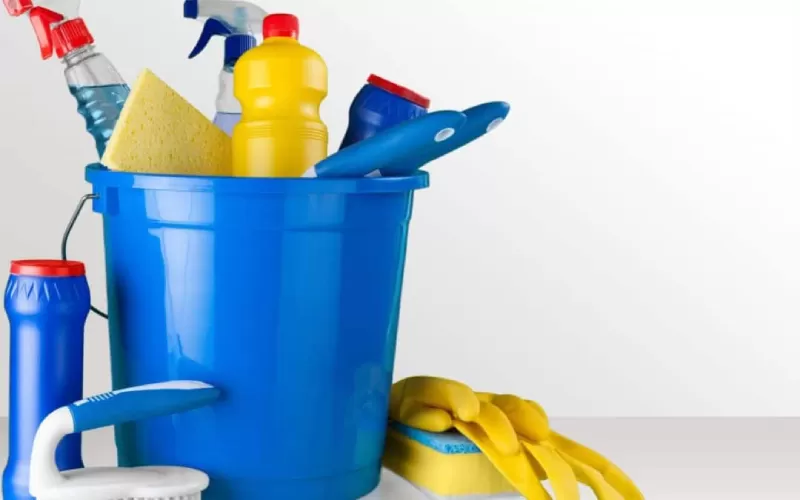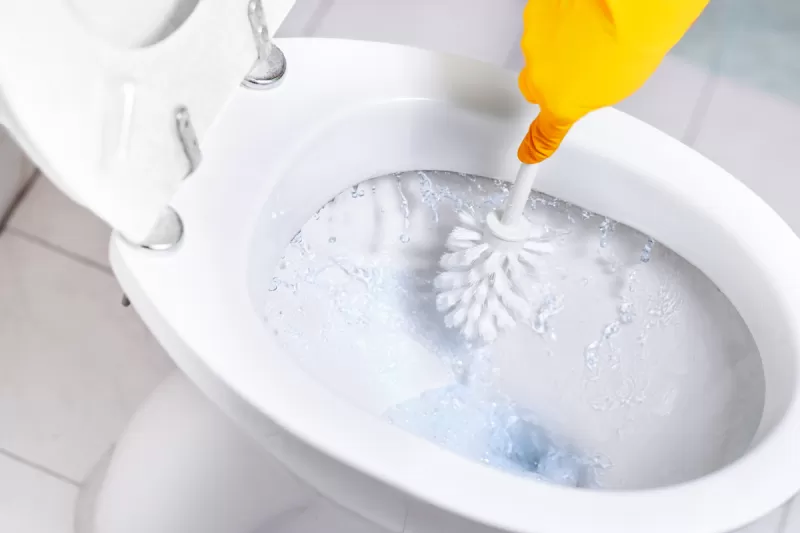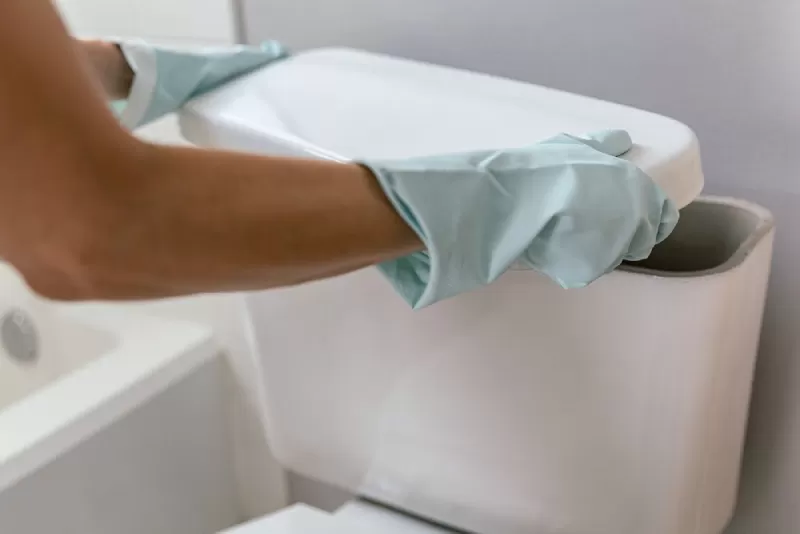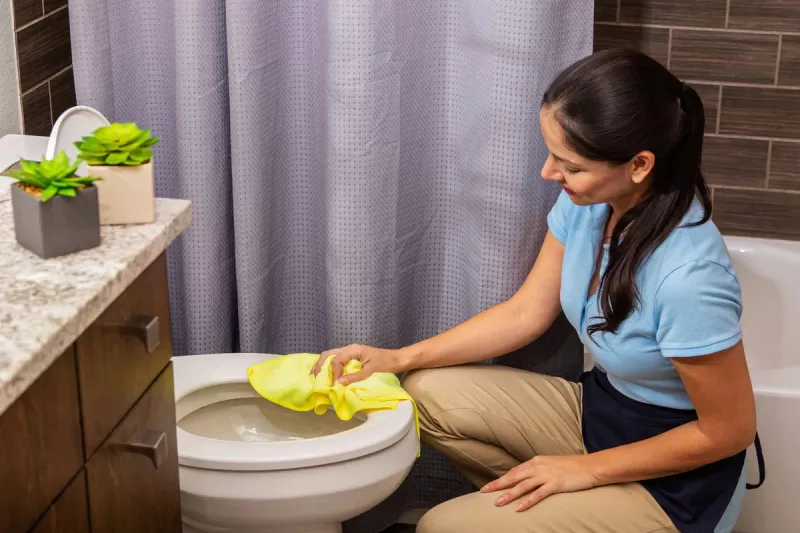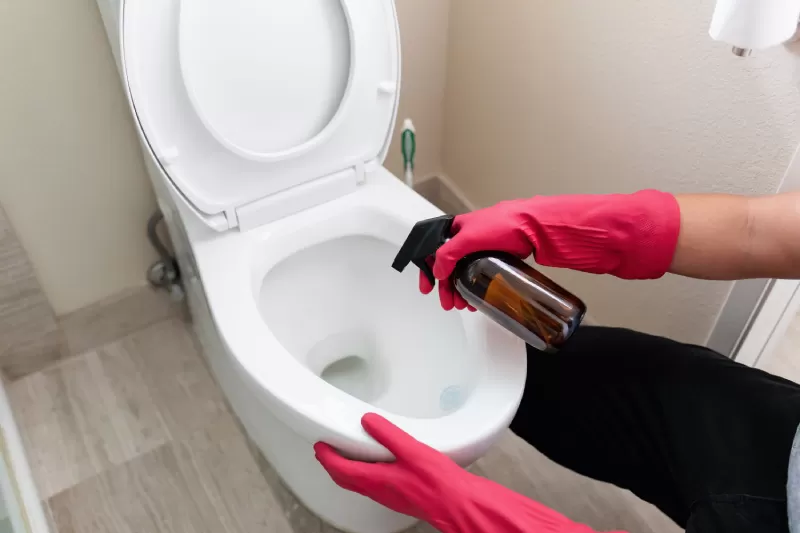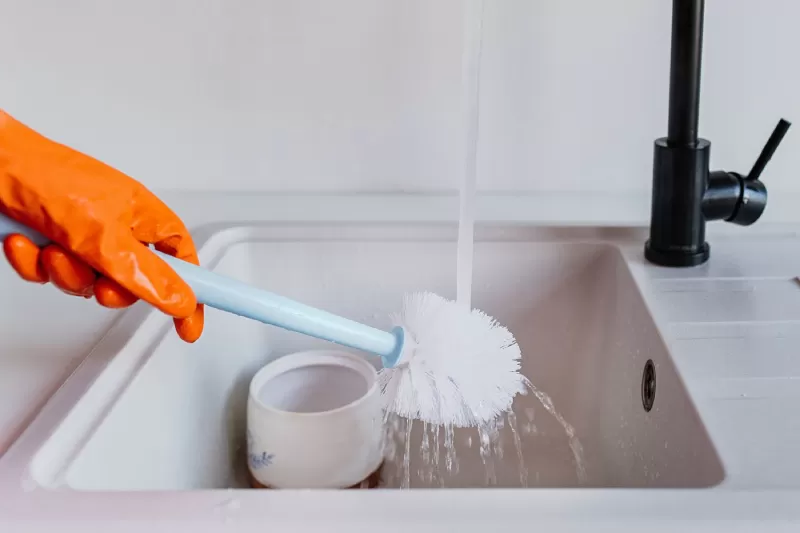No one taught us how to clean toilet stains in school. Or even how to clean the toilet seat. And to be honest, I don’t think many of us are jumping at the opportunity to do it. Having said that, knowing how to clean your toilet properly is important to avoid bacteria buildup in your bowl. Simply using a scrub brush and moving some water around isn’t enough.
That’s why we have come up with a complete guide and step-by-step list to help you learn to do a deep clean and what we like to call a maintenance clean. You can also find some cool hacks and tricks as well as answers to the most frequently asked questions. Let’s get scrubbing.
How to Clean a Toilet Step-by-Step
The first part of cleaning a toilet is understanding that there are different parts of the toilet, and all of them have to be cleaned. The frequency at which you clean each part varies, and the tools you use will be different. This section will be dedicated to a major deep cleaning of your toilet, and how to hit all the areas correctly.
How Often Should You Deep Clean?
A deep clean is different from your recommended once-a-week wipe-down. Most people shockingly wait a month before realizing the toilet might need some sprucing up. A deep clean is recommended every 10 days to two weeks. So, what does it entail?
What You Need For Toilet Cleaning Tools
- Toilet Bowl Cleaning Solution
There are a number of products you can buy online or in-store. You can also use the homemade remedies that we will share below. It’s best to avoid harmful chemicals and toxins that can leach into the air.
- A Bristled Toilet Bowl Brush
A quality brush is important. Anything that breaks down won’t be able to withstand brushing up stuck-on grime. You want to be able to apply decent pressure. You should also use a brush that has a decent length to it so you don’t feel like you have to work too hard to reach certain areas.
- Surface Cleaner/ Disinfectant
Cleaning inside the bowl isn’t the only area that needs tenderness, love, and care. You also want to wipe down all the surface area with a great disinfectant. Again, you can buy this in-store or online. We have certain recommendations listed below, as well as easy-to-make homemade natural solutions and products.
- Paper Towels or Cleaning Wipes
Paper towels are good if you don’t have anything like a microfiber cloth or rag. This will be for wiping up the disinfectant and in case any bowl water gets on the floor. Cleaning wipes or disinfectant wipes typically work better because they are less likely to disintegrate while wiping down the surface of the toilet.
Protecting yourself from gross bacteria is part of the job. Your arms or hands may need to go into the toilet bowl or other areas, so make sure to have some quality cleaning gloves that go up your forearms. Silicone is usually the way to go here.
It’s worth having a bucket around to stick your materials in. And if you are using homemade solutions for cleaning supplies, you’ll need to keep them in a bucket. A medium-sized plastic cleaning bucket will do.
Instructions Part By Part
Now, let’s divide each part and explain how to efficiently clean them. This is the most hygienic way to clean the toilet. It’s important not to rush the job; it shouldn’t chew up too much of your day if you do it right. At most, this will take an hour. Normally it takes about 30 minutes. Let’s get started.
How to clean a toilet bowl
Starting with the toilet bowl is important because you want to work from the inside out. There is a chance you may get water from the inside on the exterior, so we don’t want to go back and have to clean it twice.
Start by putting on your gloves. Once you do this, you will want to reach for the water valve that sits at the base of the toilet and turn this off. This is to lower your water levels. Lowering your water levels allows you to use a less harsh cleaner.
Why?
Because cleaners are meant to be extremely strong. After it’s placed into the toilet bowl, it will dilute. We can avoid using harsh chemicals in our homes by turning the water valve off and then flushing the toilet to lower the water level.
Scroll down to choose a less toxic cleaner and see our options for homemade solutions.
- Put your solution into the toilet bowl and allow it to soak for at least 10 minutes. Use a generous amount and apply some to the entire bowl, including under the rim. While you wait for it, you can start preparing a surface disinfectant if you don’t already have one.
- After the time is up, go ahead and use your bristle toilet brush and start scrubbing around the interior. This is the best way to clean toilet stains, so be sure to continue to scrub until any grime or build-up is long gone. Even if you can’t see anything, be sure to spend ample time going around the entire interior.
- Once you feel like you have done a good job scrubbing, you can turn the water valve back on and flush the toilet a few times to get the solution to go down the drain. Voila, you are done with the toilet bowl.
How to clean a toilet tank
Note: This is next on the list but is done best at night when you don’t need to flush the toilet for at least 12 hours. If you have two bathrooms, this is less of an issue. The longer you let the solution sit, the more time it has to self-clean for the first part.
Before getting to the surface, it’s worth taking a look at the toilet tank. Some people have never even seen the inside of their toilet tank, so this section may need an extra glace. Your toilet tank is the part that sits on top of the bowl and holds about two gallons of water that are used to flush through the bowl and pipes.
Why do we have to clean it?
Cleaning your toilet tank helps combat any grime, mildew, or rust that could build up. The good news is that you don’t need to clean the inside of the tank more than twice a year. If you want to be extra safe, you could do it every other month. The process is easy.
- Remove the lid of your toilet tank. Place it in a safe space on the floor. Preferably on a towel since it’s breakable and you don’t want to scratch the floors either.
- You don’t have to drain the water, instead simply pour in white vinegar until the water level reaches roughly an inch below the top of the rim. Let it sit for 12 hours.
- Come back the next morning and flush the toilet a few times to get the solution down the drain. Turn off the water valve again and let the water drain from the tank.
- Put your rubber gloves on and apply a cleaning solution to the inside of the tank and use your brush scrubber to help get rid of any stuck-on grime, mildew, or mineral buildup. Be sure that your cleaning solution is safe for toilet tanks as well as plastic and metal, you don’t want any chemicals to eat at the piping.
- Once the inside of the tank walls is clean, turn the water valve back on and flush the toilet a few times. Now you can put the tank back on and move on to surface cleaning.
Getting to the Surface
The surface is arguably one of the easiest parts, but it also is a part of the toilet that gets a lot of attention in terms of us using it. So a quick wipe is not always the best solution.
While the process is simply wiping down the outside with a microfiber cloth or disinfectant wipes, you want to be sure that you are going over the surface a few times. The best place to start is with the outside of the toilet tank, then move onto the toilet rim, both on the top and underneath. Underneath is where we see the germs splash up, so you may encounter some stains here.
Next, you can move down the toilet base because this area collects dust and germs as well. Usually, toilet brushes sit somewhere nearby so this entire area deserves to be cleaned and wiped down.
Cleaning Solutions We Recommend
The first tip that we tell anyone is to avoid produce that has chlorine bleach. This is because there are harmful toxins that can be irritating to your lungs. Here are some things you can buy in-store.
- Hydrogen Peroxide
- Oxygen Bleach
- Most products that say natural cleaners, such as Meyers, and brands like these.
Home Remedies That Work Great and Are Non Toxic
So many people ask how to clean a toilet with vinegar, and the best part is you just need vinegar. But we can also combine it with baking soda to make a great abrasive cleaner that does wonders.
Here is the simple recipe:
- Two cups of vinegar
- 1 cup of baking soda
Simple as that. When using it as a cleaning solution, you don’t have to mix the two ingredients at first. You can simply pour it right into the bowl.
Another great trick is to consider using salt. Salt is abrasive enough to be used when figuring out how to clean a toilet bowl stain. Technically this is a great way to unclog your toilet, so the mixture does not have to be used in small amounts. Here is the trick.
- Mix together half a cup of baking soda with half a cup of table salt in a medium or small bowl.
- Now add six cups of hot water to your bowl right after you have poured in the table salt and baking soda mixture.
- Take your toilet brush and stir the mixture in the toilet bowl for a minute or so. You want to make sure the mixture dissolves some. Then let the mixture rest overnight for eight hours as it slowly ciphers its way down the drain.
- You can take your plunger and start working on the clogged toilet the next morning. If you don’t have a clogged toilet, you can take your bristle brush and work on using the slat to get rid of some of the tougher stains.
- Even if it is not a clogged toilet, allow the mixture to rest and work on the stains naturally. Leave overnight.
Other Toilet Cleaning Solutions
Aside from baking soda, salt, and vinegar, you can also use
- Lemon juice (not lemonade) or other acidic juices
- Rosemary oil
- Natural dish soaps with antibacterial properties
Here is a list of shower cleaners for glass doors that may also be used in toilets
How To Clean A Toilet Brush
The funny thing is that no one wants to clean the tools they used to clean the toilet. But how can we continually use them if they don’t clean themselves? We either have to constantly change them out or give them the cleaning they deserve too. Note that you should also clean your toilet plunger the same way. Here is what to do.
- Start by filling up a medium-sized bucket with warm water. Don’t make the mistake of letting your toilet brush hang in the cleaning solution. Some people recommend this, but it feels like it just gets the toilet bowl dirty and the brush as well.
- Fill your bowl with your homemade cleaning solution, such as baking soda and white vinegar, and mix it around. Put your plunger and cleaning brush in the water and rinse thoroughly. Use your gloves to get in there with your hands, and wash the brush and sponge thoroughly.
- Let it soak in the solution for a few hours, discard the water in your sink, and rinse down. You may also do this if you have a safe space to discard the water outside.
Frequently Asked Questions
Now that you have a good handle on what deep clean looks like with your toilet, it’s time to answer some of the most frequently asked questions. Naturally, while the process isn’t complicated, there is still a lot of information to take in for those who haven’t been doing as thorough a job.
What Does A Maintenance Toilet Clean Look Like?
When you are not doing your deep cleans, it doesn’t hurt to wipe down your toilet with a maintenance clean in between. If you are doing deep cleans every two weeks, it’s worth wiping down the surface of your toilet every other week. This is taking your disinfectant wipes and going back to the part where you touch all the surface levels. This takes no more than 10 minutes or less.
It also doesn’t hurt to sometimes throw some toilet bowl cleaner in just to let it soak and keep grime from building up. You can pick and choose the parts of the toilet you clean as it doesn’t always have to be done together. It’s just easier to do one and do an overhaul clean every two weeks.
Should I Hire Professional Cleaners?
When it comes to cleaning your toilet, the job doesn’t stop there. You also need to do a wipe down of your shower, tub, and entire bathroom. This, of course, can take hours rather than just the short time you may spend dedicated to your toilet. A bathroom should have a maintenance clean once a week and a deep clean twice a month as well.
This is when some people find it worth it to hire a cleaning crew to come in and help. If you have the money to do so, you can find the average price to get your bathroom professionally cleaned lies between $75 to $150. Bathrooms can be the most expensive or one of the most expensive rooms to clean because they require a lot of hygienic detail since they can get dirty in a lot of areas.
How Long Does It Take to Clean My Entire Bathroom?
This is dependent on the person, but it can take a few hours, not including the time you may want the toilet solution to sit overnight. The shower and tub deserve a thorough scrub down, and then you must mop floors and wipe down bathroom mirrors. Don’t forget the vanity! Each part may require different tools and solutions since you are working with different materials.
The easiest thing to do is use homemade solutions like white distilled vinegar for an all-in-cleaner to avoid using harmful chemicals and to avoid ruining any parts of your bathroom. There are a few exceptions with materials like marble and porcelain. Be sure to read your manufacturer’s label so that you don’t void any warranties.
